Fuchsia Dunlop's Blog, page 7
March 21, 2013
A wild breakfast in Adelaide
 This excellent breakfast, enjoyed at the Big Table café in Adelaide’s Central Market, might look like a run-of-the-mill fry-up, but it’s not. I’d been browsing the market in search of local specialities, and had inevitably spent a while at the famous kangaroo shop, and another stall called Something Wild where they sell kangaroo, crocodile, goat, buffalo and camel meat. It was my last day in Adelaide, and I was dying to try some of these unusual ingredients, but none of the local cafes appeared to serve them (I think I’d only had crocodile once before, actually in a Cantonese restaurant in West London). But the incredibly kind staff at the Big Table, where I’d eaten breakfast a few days before, agreed to cook a couple of speciality sausages for me as a substitute for the bacon and eggs in their ‘Big Brekkie’. So here they are: a kangaroo country sausage from the kangaroo shop, and a crocodile sausage from Something Wild. And I’m happy to report that they were both absolutely delicious, and not disturbing in any way. The kangaroo banger was dark, juicy and peppered with fragrant herbs (it didn’t taste gamey at all), while the croc
This excellent breakfast, enjoyed at the Big Table café in Adelaide’s Central Market, might look like a run-of-the-mill fry-up, but it’s not. I’d been browsing the market in search of local specialities, and had inevitably spent a while at the famous kangaroo shop, and another stall called Something Wild where they sell kangaroo, crocodile, goat, buffalo and camel meat. It was my last day in Adelaide, and I was dying to try some of these unusual ingredients, but none of the local cafes appeared to serve them (I think I’d only had crocodile once before, actually in a Cantonese restaurant in West London). But the incredibly kind staff at the Big Table, where I’d eaten breakfast a few days before, agreed to cook a couple of speciality sausages for me as a substitute for the bacon and eggs in their ‘Big Brekkie’. So here they are: a kangaroo country sausage from the kangaroo shop, and a crocodile sausage from Something Wild. And I’m happy to report that they were both absolutely delicious, and not disturbing in any way. The kangaroo banger was dark, juicy and peppered with fragrant herbs (it didn’t taste gamey at all), while the croc sausage was gorgeously juicy and tender, a little like chicken but lighter in texture. Both were wild, sustainable, free-range meats – and in the case of the crocodile, I’d say it’s better to eat it before it eats you.
sausage was gorgeously juicy and tender, a little like chicken but lighter in texture. Both were wild, sustainable, free-range meats – and in the case of the crocodile, I’d say it’s better to eat it before it eats you.
 You can see a picture of the regular Big Brekkie on the right…
You can see a picture of the regular Big Brekkie on the right…
Just in case you were wondering if I have to eat EVERY wild animal I meet, here is a pic of me interacting very amicably with a koala, who lived to tell the tale.
And here’s a picture of another local sausage, this time laced with chilli – anyone who  remembers eating Sichuan hotpot before a long, hard-seat train journey in China will know exactly what they mean!
remembers eating Sichuan hotpot before a long, hard-seat train journey in China will know exactly what they mean!
March 19, 2013
Dumpling heaven in Adelaide
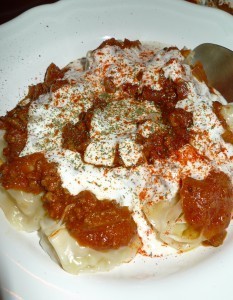
Afghan mantu
I’ve long been fascinated by the connection between Turkish mantı dumplings – and all their relatives across central and eastern Asia – and Chinese mantou (my paper on the subject from a Chinese angle will be published this summer in the Proceedings of the Oxford Food Symposium, along with a paper from the Turkish/Central Asian point of view by the Turkish food expert Aylin Oney Tan). So I was completely thrilled to come across these Afghan mantu in a gorgeous Afghan restaurant in Adelaide – the Parwana Afghan Restaurant. It’s a family business just outside the city centre where the warmth of the welcome and the charm of the ambience match the deliciousness of the food (I only came across it because the daughter of the owners was a volunteer at the Adelaide Writers’ Week and came to talk to me after one of my events, but it turns out to be highly rated by the local restaurant website, urbanspoon.com).
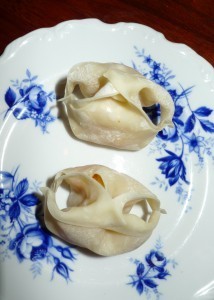
Afghan mantu - uncooked
Of course the highlight for me were the mantu dumplings: pretty little things stuffed with carrot and sauteed onion, steamed, and then slathered with a tomato and lamb stew and garlicky yoghurt, and sprinkled with paprika and dried mint. The cook and co-owner, Farida Ayubi, said they were normally stuffed with mutton and onion, but she preferred them this way, and was also keen to accommodate vegetarians where possible. The dumplings were a very interesting variant on the mantı /mantou theme: the steaming method (and original mutton-and-onion filling) connects them via the Uyghur mantı of Xinjiang with China, while their yoghurt and paprika topping is reminiscent of the serving of tiny, mutton-stuffed mantı in Turkey.
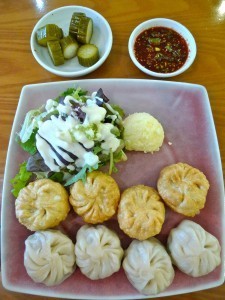
Korean mandoo
Aren’t the uncooked dumplings (shown left) pretty?! Apart from the mantu, we enjoyed rose shabat, a pink drink made with rose syrup and floaty with basil seeds, which look like frogspawn and give a mouthfeel slightly reminiscent of Taiwanese bubble tea; fabulous slices of aubergine simmered in tomato sauce and topped with yoghurt (banjan borani), fragrant grilled, marinated chicken thigh kebab served with nan bread, salad and chutney (lawang kebab), and cardamom- infused basmati rice with caramelised carrots, sultanas, slivered almonds and pistachios (Kabuli palaw).
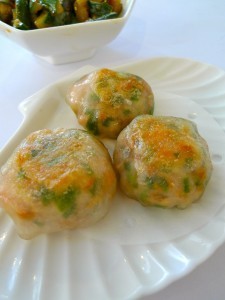
Cantonese prawn and chive dumplings
On another day in Adelaide, I lunched on Korean mandoo (right), which were what the Chinese these days generally call bao or baozi (although similar dumplings are still sometimes known as mantou in Shanghai) – little twirled dumplings, served steamed or pan-fried, with a green salad, a scoop of potato salad, pickled cucumbers and a very good chilli sauce. And on yet another day, these divine pan-fried prawn and chive dumplings (left: jiucai xiabing 韭菜虾饼) were part of a dim sum lunch (always known in these parts as yum cha) at T-Chow, in Chinatown.
James Beard award nomination!
Totally thrilled to be nominated for a James Beard journalism award for my piece in the Chinatown issue of Lucky Peach!
February 18, 2013
Curbing our greed for meat
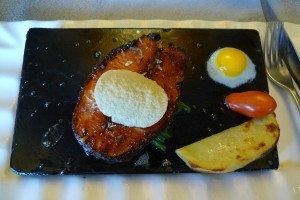 Scientists are again urging people in the developed world to eat less meat for environmental reasons. Here’s a quote from a piece on the Guardian website today, which outlined some of the environmental consequences of our addiction to cheap meat:
Scientists are again urging people in the developed world to eat less meat for environmental reasons. Here’s a quote from a piece on the Guardian website today, which outlined some of the environmental consequences of our addiction to cheap meat:
The answer, [Prof Mark Sutton, lead author of a UN Environment Programme (Unep) study published on Monday] said, was more vegetables on the plate, and less animal protein. “Eat meat, but less often – make it special,” he urged. “Portion size is key. Many portions are too big, more than you want to eat. Think about a change of culture that says, ‘I like the taste, but I don’t need so much of it.’”
By filling plates with vegetables as well as the meat, people will be better nourished. “Most people don’t notice,” he said, citing a recent UN event at which the chef used a third the amount of meat, more vegetables to make up for it, and more than 90% of guests were just as satisfied.
You know what I’m going to say… which is that if you want to eat less meat without any sacrifice in gastronomic pleasure, do cast a glance in the direction of China. The traditional Chinese diet offers such splendid ways of enjoying meat in moderation, and vegetables in plenty, that you can feed your conscience as well as your palate (this is largely what my latest book is about). Share your meat with a family or friends, or cut it up and use it to give flavour to a wokful of vegetables; use fermented black beans and pickled greens to create scrumptious umami tastes in cheap vegetarian ingredients. Interestingly, the scientist quoted above says pork and chicken – the most favoured meats in China – have the lightest environmental impact.
Ironically, of course, just when we need the Chinese to tell us how to eat well, they seem to be embarking on exactly the same path of destruction as the Western world: demand for meat in China has quadrupled in 30 years. On one of my most recent trips to Chengdu, a banquet I attended included a beefsteak for every person, individually plated in the Western style and served with knife and fork. Also served were individual steaks of salmon (pictured above), another recently-popular food, and one that is often farmed intensively, with fairly gruesome environmental consequences. (And yes, that is a Pringle you see on top of it, as a garnish.) All the other courses were served in the normal Chinese style, with chopsticks.
Perhaps it’s time for us all to remember Confucius, of whom it was said: ‘Even if the meat is plentiful, he does not let it be more abundant than the rice.’
Fuchsia Dunlop's Blog
- Fuchsia Dunlop's profile
- 392 followers



